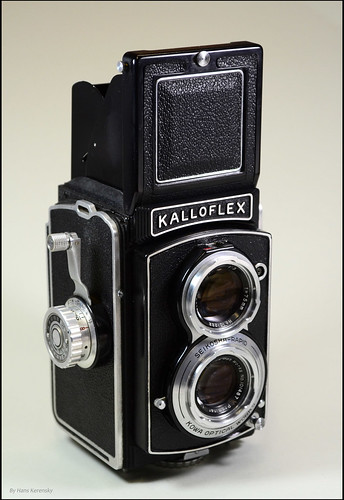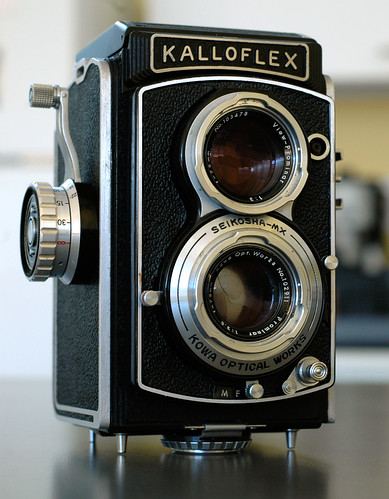Difference between revisions of "Kalloflex"
Hanskerensky (talk | contribs) m (→Links: Repaired Link URL) |
m (→Links: Updated LPA link) |
||
| (8 intermediate revisions by 2 users not shown) | |||
| Line 2: | Line 2: | ||
|image=[http://www.flickr.com/photos/echadwick/1659999430/in/pool-camerawiki http://farm3.static.flickr.com/2344/1659999430_5eebbff99a.jpg]<br>Kalloflex, second model<br><small>image by {{image author|Ed Chadwick}}</small> {{non-commercial}} | |image=[http://www.flickr.com/photos/echadwick/1659999430/in/pool-camerawiki http://farm3.static.flickr.com/2344/1659999430_5eebbff99a.jpg]<br>Kalloflex, second model<br><small>image by {{image author|Ed Chadwick}}</small> {{non-commercial}} | ||
}} | }} | ||
| − | The '''Kalloflex Automat''' was a twin-lens reflex produced by [[Kowa|Kowa Optical Works]], in two versions beginning in 1954.<ref> | + | The '''Kalloflex Automat''' was a twin-lens reflex produced by [[Kowa|Kowa Optical Works]], in two versions beginning in 1954.<ref>{{McKeown12}} p547.</ref> |
Its unique feature was a focusing knob concentric with the film-advance crank, both operated by the photographer's right hand. Kowa also opted to use a convex glass lens atop the focusing screen, rather than the more common flat fresnel lens. | Its unique feature was a focusing knob concentric with the film-advance crank, both operated by the photographer's right hand. Kowa also opted to use a convex glass lens atop the focusing screen, rather than the more common flat fresnel lens. | ||
| Line 9: | Line 9: | ||
Kalloflex advertisements proudly boasted that its four-element, 75mm f/3.5 Prominar taking lens had "an amazing resolving power of 125 lines per millimeter ''wide open''.<ref>Popular Photography magazine Volume 41 No. 1, July 1957. pg. 47.</ref> While the claim sounds dubious, the camera did gain respect among photographers as "the poor man's [[Rolleiflex]]." | Kalloflex advertisements proudly boasted that its four-element, 75mm f/3.5 Prominar taking lens had "an amazing resolving power of 125 lines per millimeter ''wide open''.<ref>Popular Photography magazine Volume 41 No. 1, July 1957. pg. 47.</ref> While the claim sounds dubious, the camera did gain respect among photographers as "the poor man's [[Rolleiflex]]." | ||
| + | |||
| + | ==Kalloflex model 1== | ||
| + | * Format : 12 exposures of 6 x 6 cm on [[120]] type rollfilm. | ||
| + | * Taking lens: Prominar 1:3.5 f=75mm, coated. | ||
| + | * Viewing lens: View-Prominar 1:3 f=75mm, coated | ||
| + | * Filter Bayonet : Both lenses, size 1. | ||
| + | * Shutter: [[Seikosha-Rapid]] leafshutter. Speeds 1 to 1/500 sec. and B. | ||
| + | * Flash synchronization : Sync socket on frontpanel. X synchronization | ||
| + | * No Selftimer | ||
| + | * Double exposure prevention | ||
| + | * Color Lacquer : Black | ||
| + | * Color Leatherette : Black | ||
| + | * Dimensions WxDxH: 105 x 95 x 140 mm | ||
| + | * Weight: 1080 grams | ||
| + | |||
{{Flickr_image | {{Flickr_image | ||
|image_source= http://www.flickr.com/photos/29504544@N08/13324989735/in/pool-camerawiki/ | |image_source= http://www.flickr.com/photos/29504544@N08/13324989735/in/pool-camerawiki/ | ||
| Line 18: | Line 33: | ||
}} | }} | ||
{{br}} | {{br}} | ||
| + | |||
| + | ==Kalloflex model 2== | ||
| + | <i>Only differences with Kalloflex model 1 shown.</i> | ||
| + | * Shutter: [[Seikosha-MX]] leafshutter. Speeds 1 to 1/500 sec. and B. | ||
| + | * Flash synchronization : Sync socket on frontpanel. M-F-X synchronization | ||
| + | * Release button transport lock | ||
| + | * Enable double-exposure knob | ||
| + | * Weight: 1130 grams | ||
| + | |||
==Notes== | ==Notes== | ||
<references/> | <references/> | ||
| Line 29: | Line 53: | ||
In English: | In English: | ||
| − | * [ | + | * [https://www.leitz-auction.com/en/Kowa-Kalloflex-II/AI-22-14327 Kalloflex automat] with 75 mm f/3.5 taking lens, View-Prominar f/3 viewing lens, and Seikosha-MX shutter, sold at the [https://www.leitz-auction.com/en/Cameras/Past-Auctions/Auction-22/ 22nd Westlicht Photographica Auction], on 24 November 2012 |
* [http://www.butkus.org/chinon/kallo_flex/kallo_flex-splash.htm Kalloflex instruction manual] at Mike Butkus' [http://www.butkus.org/chinon/ Orphan Cameras] | * [http://www.butkus.org/chinon/kallo_flex/kallo_flex-splash.htm Kalloflex instruction manual] at Mike Butkus' [http://www.butkus.org/chinon/ Orphan Cameras] | ||
Latest revision as of 19:45, 22 January 2024
The Kalloflex Automat was a twin-lens reflex produced by Kowa Optical Works, in two versions beginning in 1954.[1]
Its unique feature was a focusing knob concentric with the film-advance crank, both operated by the photographer's right hand. Kowa also opted to use a convex glass lens atop the focusing screen, rather than the more common flat fresnel lens.
The Kalloflex was positioned at the top of the price spectrum for Japanese TLRs, advertised in US photography magazines circa 1957 at a list price of USD $119.50, despite its absence of a light meter. (A Yashica Mat of the time, also with crank wind and a 4-element Lumaxar lens, listed for USD $75.50.)[2]
Kalloflex advertisements proudly boasted that its four-element, 75mm f/3.5 Prominar taking lens had "an amazing resolving power of 125 lines per millimeter wide open.[3] While the claim sounds dubious, the camera did gain respect among photographers as "the poor man's Rolleiflex."
Kalloflex model 1
- Format : 12 exposures of 6 x 6 cm on 120 type rollfilm.
- Taking lens: Prominar 1:3.5 f=75mm, coated.
- Viewing lens: View-Prominar 1:3 f=75mm, coated
- Filter Bayonet : Both lenses, size 1.
- Shutter: Seikosha-Rapid leafshutter. Speeds 1 to 1/500 sec. and B.
- Flash synchronization : Sync socket on frontpanel. X synchronization
- No Selftimer
- Double exposure prevention
- Color Lacquer : Black
- Color Leatherette : Black
- Dimensions WxDxH: 105 x 95 x 140 mm
- Weight: 1080 grams

|
| Kalloflex, first model image by Hans Kerensky (Image rights) |
Kalloflex model 2
Only differences with Kalloflex model 1 shown.
- Shutter: Seikosha-MX leafshutter. Speeds 1 to 1/500 sec. and B.
- Flash synchronization : Sync socket on frontpanel. M-F-X synchronization
- Release button transport lock
- Enable double-exposure knob
- Weight: 1130 grams
Notes
- ↑ McKeown, James M. and Joan C. McKeown's Price Guide to Antique and Classic Cameras, 12th Edition, 2005-2006. USA, Centennial Photo Service, 2004. ISBN 0-931838-40-1 (hardcover). ISBN 0-931838-41-X (softcover). p547.
- ↑ Popular Photography magazine (USA) Volume 41 No. 1, July 1957. "Twin Lens Roundup" pgs. 64-69.
- ↑ Popular Photography magazine Volume 41 No. 1, July 1957. pg. 47.
Bibliography
- Watakushi no ni-gan-refu kamera-ten (私の二眼レフカメラ展, Exhibition of twin lens reflex cameras). Tokyo: JCII Camera Museum, 1992. (Exhibition catalogue, no ISBN number.) P.29.
Links
In Japanese:
In English:
- Kalloflex automat with 75 mm f/3.5 taking lens, View-Prominar f/3 viewing lens, and Seikosha-MX shutter, sold at the 22nd Westlicht Photographica Auction, on 24 November 2012
- Kalloflex instruction manual at Mike Butkus' Orphan Cameras
